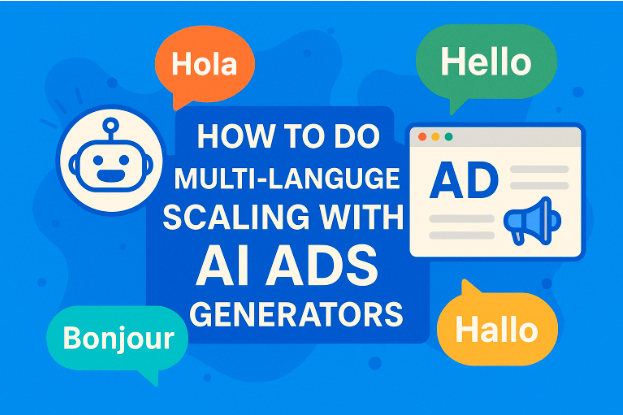Have you ever crafted a killer ad campaign – one that’s witty, sharp, and guaranteed to delight your customers, only to realize translating that magic for a global audience feels impossible? Whether you’re a small business owner or part of a growing team, multi-language scaling with AI ad generators is your ticket out of the “lost in translation” nightmare and into real global growth.
Let’s make this easy, even if you’ve never done marketing before, and break down the whole journey. Not just the nuts and bolts, but the real, everyday struggles and how brands (big and small) use AI technology to overcome them.
Why Scaling Ads Across Languages Matters Now
We live in a world with billions of voices. Shouting in one language, hoping everyone “gets it”, is a little like launching your product with no roadmap. People want to see brands talk to them, not just throw generic ads into the void.
Just look at how Spotify runs Ramadan stories in Arabic and rides the K-pop wave in Korean. Or how Nike tweaks storytelling and visuals for each region—whether it’s India, Brazil, or the U.S. That’s not just translation, it’s emotional connection. The return? Higher engagement, better click-through rates (CTR), and lasting brand loyalty.
But what if your budget is nowhere near theirs? That’s where AI ad generators come in.
What Is an AI Ad Generator?
In simple terms: an AI ads generator is a tool that automatically creates ad copy, images, and even video content. Many can instantly translate ads into dozens of languages and tailor content for each region or social media platform.
Think of it like having a fast, reliable assistant—one that can spit out creative ideas, translations, and optimized visuals at lightning speed.
Real Challenges People Face
Let’s get honest: scaling ads into multiple languages used to be:
- Expensive: You needed translation teams, cultural consultants, and designers for every market.
- Slow: Campaign launches stalled for weeks, all because content needed to get proofed, translated, and redesigned each time.
- Risky: Poor translations and generic imagery led to embarrassing gaffes or lost trust. (Anyone remember those infamous Pepsi, KFC mistranslations?)
How AI Ad Generators Solve These Problems
1. Speed and Efficiency
With AI, you can produce hundreds of variants, in multiple languages, in hours, not weeks.
Imagine a campaign that needs French, Hindi, Mandarin, and Spanish ads. Old-school way: hire native writers, brief designers, translate and wait.
AI way: Write your core message in English (or whatever’s most comfortable), select your desired languages, and the system generates localized copy and visuals in a flash.
2. Cost Savings
No more hiring several different teams. You pay for one AI tool that does it all. Even small brands have broken into new markets using inexpensive AI generators, saving up to 80% in time and money over traditional methods.
3. Quality and Consistency
AI tools can maintain brand voice across translations. You set your tone, review translations, and tweak as needed. Some platforms (like AdGPT, Creatify, Rocketium) even let you A/B test phrasing, adjust for cultural nuances, and enforce brand guidelines automatically.
4. Visual Adaptation
AI ads generator don’t just translate words, they adapt visuals. Red may mean “sale” in the U.S., but “luck” in China. With AI, you can swap images, avatars, or colors according to local meaning.
5. Human Review Is Still Crucial
No AI can fully replace the human feeling—idioms, humor, emotional context. The final step is always human review. Even solo entrepreneurs can tap local freelancers or ask bilingual friends to ensure everything feels right.
Step-by-Step: Scaling Multi-Language Ads With AI Generators
Here’s a simple playbook, shaped by best practices—and a few extras most blogs miss.
Step 1: Start With Your Strongest Message
Write your ad in your “home” language, focusing on what makes your brand stand out. Keep sentences crisp and clear. AI performs best with short, punchy copy.
Step 2: Pick Your AI Ad Generator
Some top tools:
- AdGPT: Focused on control, review, and refined translation.
- Creatify: Turns product URLs into multilingual video ads, with avatars speaking native languages.
- Typeface: Great for rapid customization across ad formats and locations; lets you edit tone and visuals for each market.
- Rocketium: Auto-sizes visuals, enforces brand compliance, and makes spreadsheet-based edits for fast scaling.
Step 3: Select Platforms and Templates
AI platforms let you pick the ad placement (Instagram, Facebook, Google, etc.) and customize templates for each one—remember, different languages have different character counts and layouts.
Step 4: Generate and Refine Translations
Let the AI do the first pass, then review every version. Tweak for tone, slang, and local habits. For extra safety, get a native speaker’s input—many tools make collaboration easy.
Step 5: Adapt Visuals
Switch up images, colors, icons, and even avatars so your ad looks and feels local. Context matters—a hand gesture that’s fine in Berlin can offend in Tokyo.
Step 6: Organize, Export, and Test
Label all assets clearly. Avoid “final_FINAL_edit” file chaos. Start with microbudgets and small A/B tests for each market. Try different tones (formal, fun, local slang) and visuals, then monitor engagement and adjust quickly.
Step 7: Keep Human Touch
Review everything. AI takes you 80–90% of the way, but that last bit—the emotion, the nuance, the connection—is uniquely human.
Real Brand Examples
- Spotify: Localizes music campaigns—like Ramadan playlists in Arabic and Korean pop culture in Korean—using AI tools for speed but always adding local flair.
- Nike: Runs visual ads with different models, cultural references, and stories for every region. Their Brazilian campaign featured local sports icons and idioms, while Southeast Asia’s campaign focused on local athletes and color meanings.
- Small businesses: Indie bakeries, pet groomers, and SaaS startups have turned product URLs into instant, bilingual video ads with Creatify. One Portland pet care center saw 2X engagement when switching from English-only ads to Spanish and Chinese digital avatars.
Going Beyond Translation: Cultural and Social Sensitivity
True scaling is more than language—it’s local context, humor, slang, buying habits, even fonts and colors.
- Set clear guidelines: Keep a “do’s and don’ts” doc for each market.
- Personalize per location: Offer local references (weather, holidays, events).
- Test cultural nuances: Emojis, jokes, and idioms can make or break engagement.
Bonus: Scaling With Automation and Collaboration
Modern AI ads generator now support collaborative workflows—multiple contributors can edit, approve, and localize ads directly in the platform. Security settings mean only certain team members can tweak branding, while translators help perfect the copy.
Automation can also reformat your ads for every channel (Instagram, TikTok, Google Ads) and every device, ensuring seamless brand experience everywhere.
Pitfalls to Avoid
- Blind trusting AI: Always have a human review, especially for sensitive markets.
- One-size-fits-all visual design: Each location needs different visuals and sometimes different ad formats.
- Generic stock photos: Audiences see through bland, “global” imagery. Be specific and authentic.
Where AI Ends and Meaning Begins
You don’t need a translation team in every time zone. You don’t need massive budgets.
You just need to test, listen, and adapt.
Let AI do the heavy lifting, so you can connect at the speed of global conversation—while keeping control and heart over your brand’s voice.
Final Thoughts
Scaling ads across languages with AI isn’t just the future—it’s the present for brands of every size. AI ad generators break down the walls that kept global growth out of reach, making it simple to launch, test, and refine campaigns for every audience.
Let technology handle the hustle. You stay in charge of the message.
Speak in their language—on their terms, with your story.







